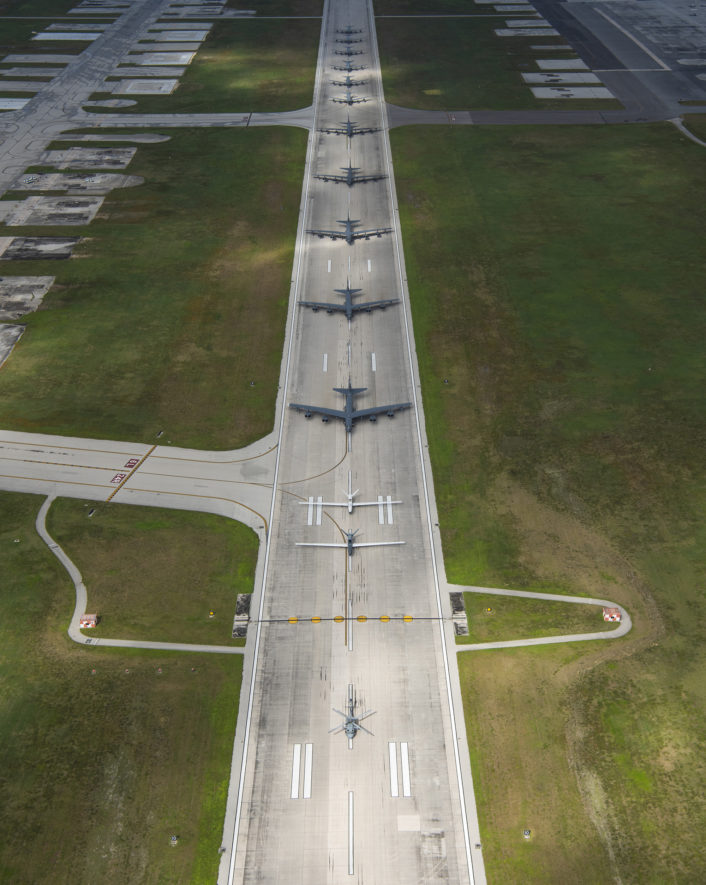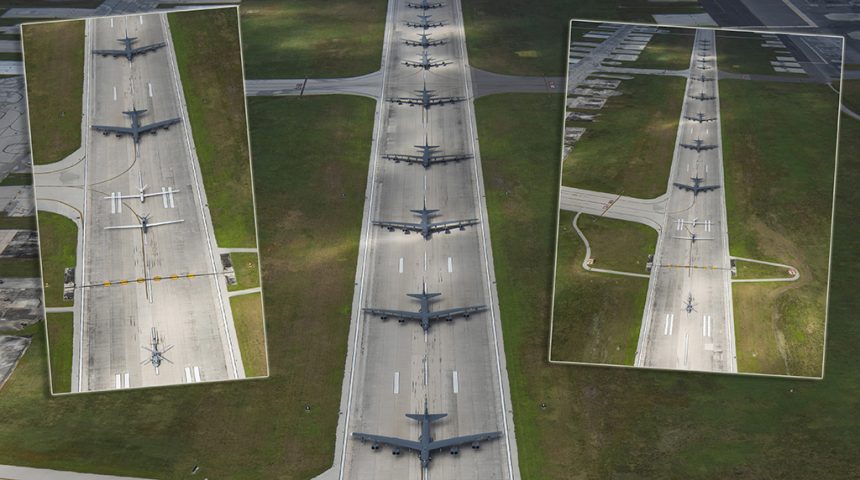A joint “Elephant Walk” featuring strategic bombers, tankers, and the recently arrived Triton, was staged at the U.S. military outpost in the Western Pacific.
Strategically located 1,800 miles (about 2,900 km) to the east of China, Andersen AFB has hosted a deployed strategic bomber force since 2004. B-52s, B-1s and B-2s are regularly deployed to Andersen AFB, Guam, in support of U.S. Pacific Command’s (CBP) Continuous Bomber Presence mission.
Since the end of January the military outpost has hosted also the Navy’s largest unmanned aerial vehicle: the MQ-4C Triton. The first two of four Tritons expected to be based there by 2021, have arrived at Andersen Air Force Base for a deployment in the Indo-Asia-Pacific region.
Assigned to the Unmanned Patrol Squadron One Nine (VUP-19) DET Point Mugu, the MQ-4C are deployed with an early set of capabilities, including basic ESM (Electronic Support Measures) to pick up ships radar signals, for maritime Intelligence Surveillance Reconnaissance mission. A more significant SIGINT (Signal Intelligence) capability will be deployed to the fleet next year, when the Triton is expected to reach an IOC (Initial Operational Capability). By then, the U.S. Navy plans to add two additional MQ-4Cs to the Guam deployment that would allow a 24/7/365 orbit. With the IOC of the Triton, the service will retire the EP-3E ARIES II as the Navy’s signals-intelligence platform.
As already explained in a previous post about the delivery of the first MQ-4Cs to VUP-19:
The U.S. Navy’s MQ-4C “Triton” Broad Area Maritime Surveillance (BAMS) is an ISR (Intelligence Surveillance Reconnaissance) platform that will complement the P-8A Poseidon within the Navy’s Maritime Patrol and Reconnaissance Force family of systems: for instance, testing has already proved the MQ-4C’s ability to pass FMV (Full Motion Video) to a Poseidon MPA (Maritime Patrol Aircraft). An advanced version than the first generation Global Hawk Block 10, the drone it is believed to be a sort of Block 20 and Block 30 Global Hawk hybrid, carrying Navy payload including an AN/ZPY-3 multi-function active-sensor (MFAS) radar system, that gives the Triton the ability to cover more than 2.7 million square miles in a single mission that can last as long as 24 hours at a time, at altitudes higher than 10 miles, with an operational range of 8,200 nautical miles.
The U.S. Navy plans to operate five 24-hour orbits around the world. The UAVs will be controlled from two MOBs (Main Operating Bases): Naval Station Mayport, Florida, and Naval Air Station Whidbey Island, Washington. The aircraft will be launched (and recovered) from 5 bases: Naval Air Station Sigonella, Italy; an unspecified location in the Middle East (Al Dhafra, UAE, where the U.S. Air Force RQ-4 are forward deployed?); Naval Air Station Guam; Naval Station Mayport; and Point Mugu.
Along with a U.S. Navy MH-60S Knighthawk a U.S. Air Force RQ-4 Global Hawk, five U.S Air Force B-52 Stratofortress bombers and six KC-135 Stratotankers also stationed at Andersen Air Force Base, Guam, one of the two deployed MQ-4Cs took part in an “Elephant Walk” organized by the 36th Wing on Apr. 13, 2020.
During Elephant Walk exercises military aircraft taxi in close formation or in sequence right before a minimum interval takeoff and, depending on the purpose of the training event they then either take off or taxi back to the apron. It’s a readiness exercise but it’s also a good opportunity to take some cool shots like the one below.










